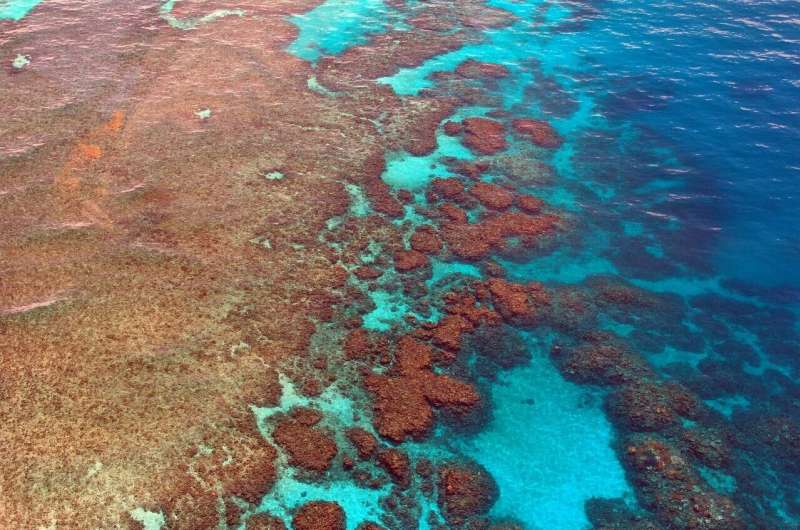This article has been reviewed according to Science X's editorial process and policies. Editors have highlighted the following attributes while ensuring the content's credibility:
fact-checked
peer-reviewed publication
trusted source
proofread
Shading the Great Barrier Reef from the sun might slow bleaching-induced coral decline

Over the past two decades, coral reefs have declined at unprecedented rates. This is in part because of extreme weather events, which cause wide-spread coral bleaching, a process during which corals lose their color because of stressors, including changes in water temperature, light, or nutrient availability. One of the worst mass bleaching events occurred in 2016 and 2017 on the Great Barrier Reef, causing bleaching on 91% of the system's reefs.
As frequency and severity of mass bleaching events are expected to increase in the future, researchers are looking for ways to protect corals from excessive radiation and temperatures. As part of the Cooling and Shading subprogram of the Reef Restoration and Adaptation Program (RRAP), which is developing solutions to help coral reefs resist, adapt to, and recover from warming ocean temperatures, researchers in Australia have examined the effectiveness of shading on two coral species.
"We show that intermittent shading under controlled conditions can moderate light stress and slow bleaching," said Dr. Peter Butcherine, a research fellow at Southern Cross University and lead author of the study published in Frontiers in Marine Science. "Reducing sunlight by 30% for four hours around solar noon can slow the onset of the bleaching response in some thermally-stressed shallow corals."
Just four hours of shade slows bleaching
Researchers collected two species of stony corals, Turbinaria reniformis, commonly known as yellow scroll coral, and Duncanopsammia axifuga, also called whisker coral. After transportation and acclimatization to a lab, tanks containing coral fragments were covered with 30% shade cloth for either four hours around noon, or 24 hours. Shading corals for four hours in the middle of the day recreates light reductions similar to those on a cloudy day.
Results showed that shaded corals bleached significantly less than unshaded ones, and corals that were shaded for 24 hours bleached less than those shaded for four hours. Higher water temperatures also favored bleaching.
Shading delayed the corals' bleaching response by up to three degree heating weeks (DHW). Corals begin to accrue DHW once water temperature exceeds the maximum monthly mean water temperature by more than 1°C. After surpassing this threshold, they start to bleach. When heat stress reaches four DHW, significant coral bleaching can be observed.
Different responses to shading
Corals, however, did not respond in the same way to shading. For T. reniformis, 30% shading for four hours a day was found enough to delay bleaching. The shading response of D. axifuga, however, was more limited: While the coral responded to 24-hour shading until three DHW, it became unresponsive afterward.
"The complex nature of coral interactions with their environment means there are likely to be a range of responses to shading. We showed that coral species can respond differently when shaded, but these differences were not necessarily detrimental, just different from each other," Butcherine explained.
Yet, no matter how well corals respond to shading, thermal stress in intense prolonged marine heat waves can still overwhelm the shading benefit, the researchers pointed out.
How to shade a reef
"This work directly informs the development of cooling and shading interventions to help protect the Great Barrier Reef during future bleaching events," said Dr. Daniel Harrison, a researcher at Southern Cross University and program lead of RRAP Cooling and Shading. "Coral reefs are a critically important ecosystem so it is vital to investigate all the possible ways we can help them survive climate change."
There are several ways to shade reefs, including the use of artificial coverings and seawater fogging systems. The latter is one of the interventions that researchers in the RRAP Cooling and Shading program are working on. "The focus of the fogging technologies we are developing is for deployment at an individual reef site of some tens of hectares in size," Harrison continued. Currently, the team's efforts are aimed at localized cooling and shading of small high-value reef environments.
"Our trials show some promising results, but there is still more research and development required before the current technologies are ready for scaled up deployment in the field," Harrison concluded.
More information: Intermittent shading can moderate coral bleaching on shallow reefs, Frontiers in Marine Science (2023). DOI: 10.3389/fmars.2023.1162896
Journal information: Frontiers in Marine Science
Provided by Frontiers


















